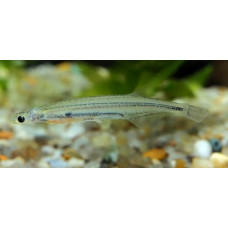Latin name
Vandellia cirrhosa
Other name
Сañero, toothpick fish, or vampire fish.
Identification
The candiru has an elongated body, a small head, and an abdomen that may appear swollen, especially after a large, bloody meal. Short sensory antennae surround the head, and short backward-pointing spines are located on the gill covers. These spines have been described as protruding like an umbrella and are used to help the fish penetrate its host.
Features of fish fins
This fish has a body with anterior dorsal and ventral fins. The anal fin is slightly larger than the dorsal fin. Its caudal fin is small and truncated.
Fish colouring
The candiru's translucent body makes it difficult to spot in the murky waters of its habitat. After feeding, blood is often visible through its body. The fish has small eyes with yellow irises.
Distribution
Vandellia cirrhosa is widespread in the Amazon and Orinoco river basins of lowland Amazonia. The Purus River in Brazil is one of the places where Vandellia cirrhosa is known to live. This location is difficult to study due to its geographical isolation, which is common among candiru habitats.
Habitat
It is a tropical, freshwater, demersal species. It inhabits shallow waters with muddy, sandy, or rocky bottoms. It can be found in reefs. Vandellia cirrhosa is unevenly distributed and does not appear to stray far from its spawning grounds.
Size
The fish is no longer than 15 cm. Often, specimens no larger than a matchstick are found.
Behavior
They are active during the day and at night.
The candiru is a parasite that lives off other fish. The catfish senses the flow of water exhaled by other fish and swims into their gills. It spreads its spiny growths at the same time and feeds on blood from the blood vessels in the gills. This is why it has been nicknamed the “Brazilian vampire.” The catfish does not suck blood; after biting, the blood flows out of the gills on its own. Within 30 to 145 seconds, the catfish is satiated and leaves its host fish.
Food and feeding habits
They feed exclusively on blood. This hematophagous species parasitizes the gills of large Amazonian fish, particularly catfish from the Pimelodidae and Characidae families. However, they are known to parasitize many species in the same location, suggesting that their feeding habits are based on availability rather than species preference.
Modern experiments have shown that the candiru approaches its host fish, swimming alongside it until it reaches the gill cover. It then attempts to enter the gill chamber by squeezing underneath the cover. Candiru has also been observed entering the host's body through the mouth, though this behavior appears to be rare. Candiru clamps its sharp teeth into the gill chamber of its host fish and quickly swells with blood. This species' intestine is a straight tube with loosely arranged fibers lining the connective tissue walls, which most likely contributes to the abdominal swelling characteristic of the Candiru. The absence of a protruding jaw confirms the theory that the Candiru does not suck blood but rather bites through a blood vessel and swallows the freely flowing blood. Since the candiru relies on the blood pressure of its host to absorb blood from the abdominal or dorsal arteries, the host fish should be selected based on size.
Reproduction
Reproduction of candiru in the wild has not been studied. Only one case of this fish spawning in captivity has been recorded. The male swam around the female and pushed her toward the substrate. The fish released eggs and sperm when they were in close lateral contact with each other. The female laid four to five eggs at a time, with reproduction occurring several times over a period of three days.
Fishing
This species is not commercially important.
Currently, the Purus River is the main source of fish for human consumption in Manaus, the most densely populated city in the Central Amazon region. The candiru puts enormous pressure on fish stocks by depleting the population of potential host fish.
Relationship with a person
Local residents reportedly fear this fish because they believe it can swim into a naked person's anus, vagina, or—in the case of small specimens—penis, reaching as far as the bladder. There, it allegedly feeds on blood and surrounding tissue, causing severe pain. The fish is said to find its victims by detecting ammonia in the water, released from the gills during breathing or, in humans, from the urethra. According to the myth, it is often impossible to remove the fish without surgical intervention. In most cases, the surgeries are performed without complications. Traditionally, juices from two plants, particularly genipa, are applied directly to the site where the fish is attached. This causes the fish to die and decompose. Without medical assistance, candiru infestations can lead to death. The fish always dies because it cannot escape the human body. However, there has never been a documented case of a Candiru fish getting stuck in a human urethra. It has also not been proven that the fish is attracted to human urine.
| Classification | |
| Phylum | Chordata |
| Class | Actinopterygii |
| Squad | Siluriformes |
| Family | Trichomycteridae |
| Genus | Vandellia |
| Species | V. cirrhosa |
| Features | |
| Conservation status | Least Concern |
| Habitat | Bottom |
| Life span, years | No information |
| Maximum body weight, kg | No information |
| Maximum length, cm | 15 |
| Sailing speed, m/s | No information |
| Threat to people | Not edible |
| Way of eating | Predator |
Candiru
Tags: candiru



